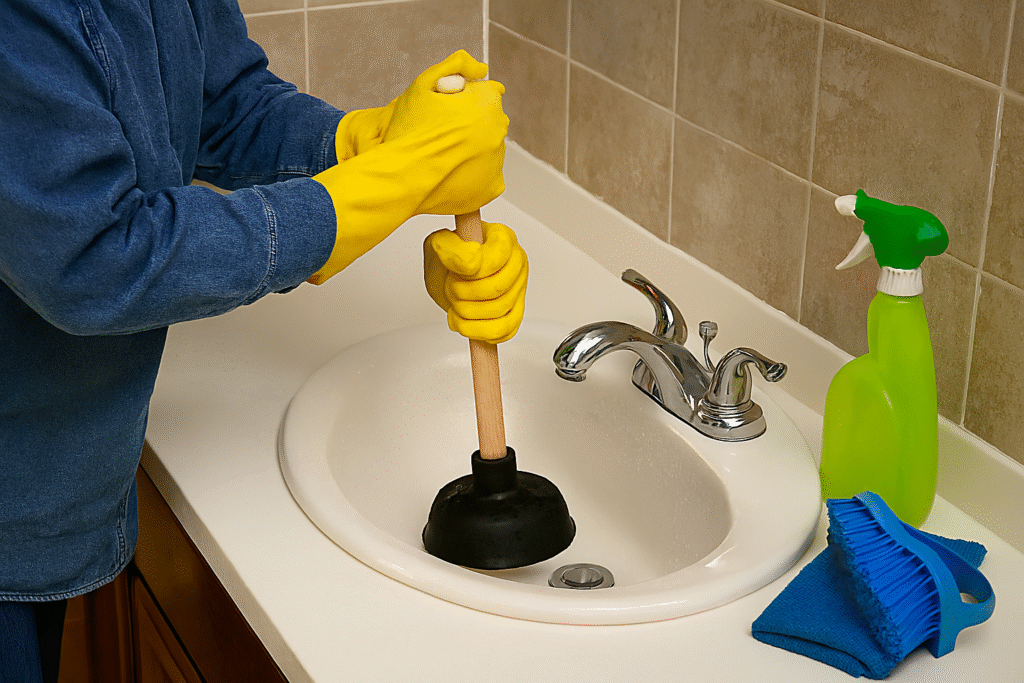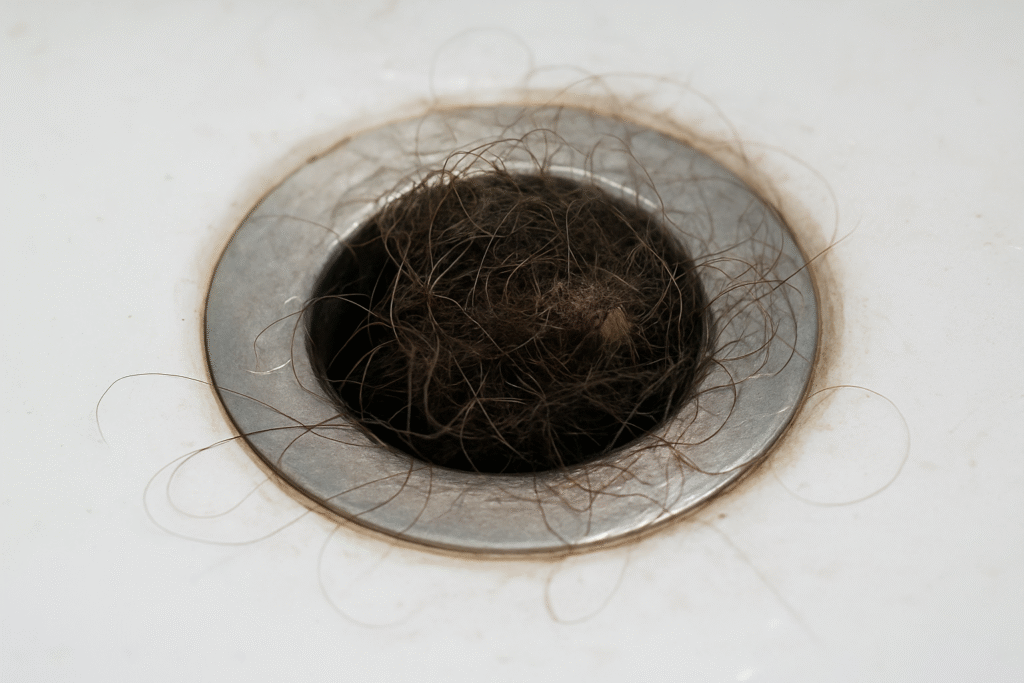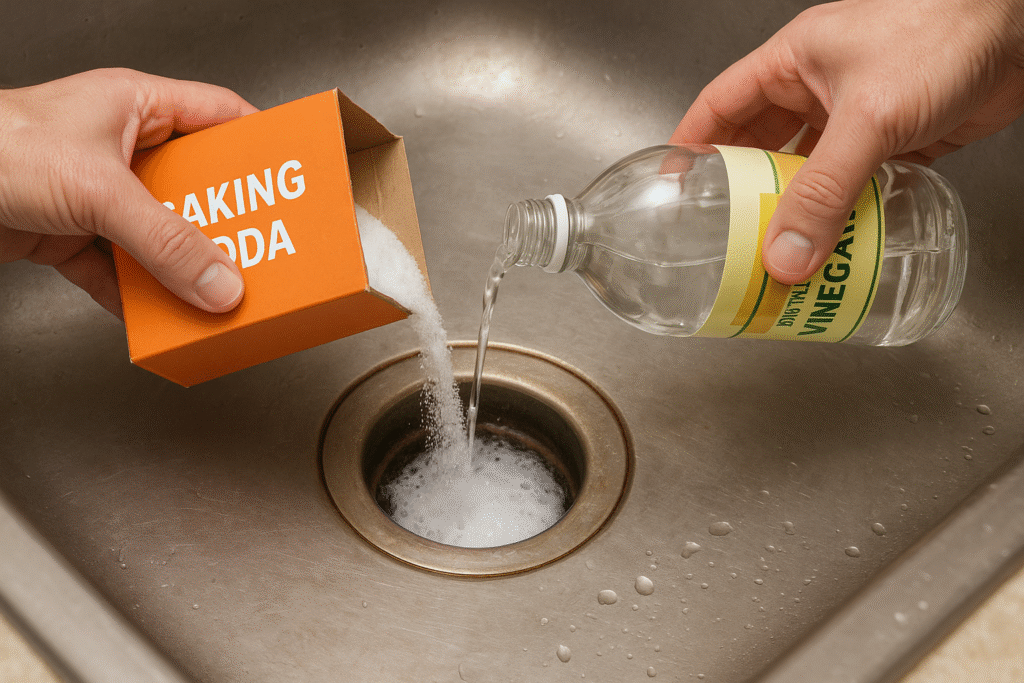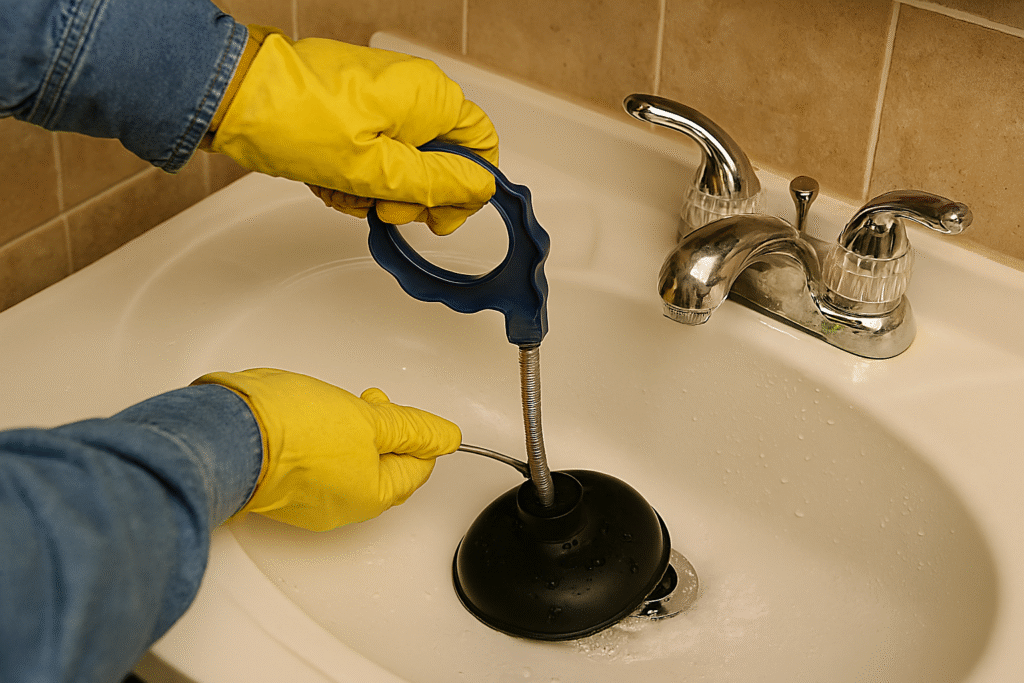Step-by-Step Guide for Homeowners

A clogged drain is one of the most common household annoyances—but you don’t always need a plumber to fix it. With the right tools, some elbow grease, and a little know-how, you can clear your sink, bathtub, or shower drain in no time. This guide walks you through simple, effective methods to unclog drains safely and prevent future blockages.
Common Causes of Drain Clogs
- Hair buildup: A top culprit in bathroom sinks and showers.
- Grease and food waste: Common in kitchen sinks.
- Soap scum and minerals: Can create stubborn blockages over time.
- Foreign objects: Small toys, jewelry, or debris accidentally dropped down drains.
- Kitchen prep aftermath: Sink clogs often happen right after cooking because food scraps, grease, and oils get rinsed down the drain. Even small bits of rice, pasta, or vegetable peels can swell or tangle together, leading to a blockage.
💡 Pro Tip: Most kitchen sink clogs happen right after meal prep. To prevent them, scrape plates into the trash or compost bin, avoid rinsing grease down the sink, and use a drain strainer to catch small scraps before they sneak into your pipes.

Tools You’ll Need
- Plunger (sink or toilet plunger)
- Drain snake or auger
- Baking soda and vinegar (natural solution)
- Boiling water
- Bucket and gloves
- Pipe wrench (for P-trap removal if needed)
Suggested products:
- Drain Snake: Amazon Basics Drain Snake
- Heavy-Duty Plunger: Korky Toilet & Sink Plunger
- Eco-Friendly Drain Cleaner: Green Gobbler Liquid Hair Drain Clog Remover & Cleaner
1.3 Gallon Compost Bucket for Kitchen with Lid, Includes 1 Spare Charcoal Filter, Home Essentials – (Silver)
We earn a commission if you make a purchase, at no additional cost to you.
Step 1 – Try the Plunger

- Fill the sink or tub with enough water to cover the plunger’s cup.
- Place the plunger over the drain, ensuring a tight seal.
- Push and pull vigorously for 20–30 seconds.
- Remove the plunger and check if the water drains.
Tip: A plunger works best on clogs caused by hair, soap, and small debris.
Step 2 – Use Baking Soda and Vinegar
- Pour 1 cup of baking soda down the drain.
- Follow with 1 cup of vinegar.
- Cover the drain and let it fizz for 15–30 minutes.
- Flush with boiling water.
Tip: This method is natural, safe for pipes, and effective for minor clogs.

Step 3 – Snake the Drain

- Insert a drain snake or auger into the drain.
- Turn the handle clockwise, pushing the snake deeper until resistance is felt.
- Rotate and pull out debris carefully.
- Run hot water to clear remaining residue.
Tip: Snaking is ideal for stubborn clogs that plunger or baking soda methods can’t fix.
Step 4 – Remove and Clean the P-Trap (If needed)
- Place a bucket under the sink to catch water.
- Loosen the P-trap using a pipe wrench.
- Remove debris and rinse the trap with hot water.
- Reattach the P-trap and test the drain.
Tip: Only attempt this if the clog is deep or persistent.
Prevent Future Drain Clogs
- Use a drain strainer to catch hair and food particles (your pipes don’t need a wig or leftovers).
- Avoid pouring grease down the sink—treat it like an ex: don’t let it slide back into your life.
- Run hot water weekly to flush away buildup. Think of it as a spa day for your plumbing.
- Periodically clean drains with baking soda and vinegar—your pipes will fizz like they just won the lottery.
When to Call a Professional
- Drain remains clogged after multiple attempts.
- Multiple drains are slow, indicating a main line issue.
- Foul odors persist despite cleaning.
- Frequent recurring clogs.
Helpful Hardware Guy’s Tip: For persistent issues, find a licensed plumber near you or check our list of trusted plumbing tools.
Why Chemical Drain Cleaners Are a Bad Idea
When faced with a slow or clogged drain, it’s tempting to grab a bottle of chemical cleaner from the store. But while these products promise quick results, they often do more harm than good. Here’s why:
- Pipe Damage – Chemical drain cleaners generate heat and corrosive reactions. Over time, they can eat away at PVC pipes, weaken metal, and even cause joints to leak. What starts as a small clog could end with a costly plumbing repair.
- Toxic Fumes – The harsh chemicals release vapors that can irritate your eyes, nose, throat, and lungs. Using them in a confined bathroom or kitchen can quickly turn unpleasant—and potentially unsafe.
- Environmental Harm – Once rinsed down the drain, these chemicals don’t just disappear. They can make their way into local water systems, harming aquatic life and disrupting ecosystems.
- Temporary Fix, Not a Solution – At best, chemical cleaners break up part of a clog, but they rarely remove the entire blockage. This means you’ll probably face the same problem again—only with weaker pipes this time.
Safer alternatives, like a plunger, drain snake, or natural cleaning solutions (baking soda and vinegar), clear clogs without putting your plumbing, health, or environment at risk.
| 🚫 Chemical vs. ✅ Natural Drain Cleaning | Chemical Cleaners | Natural Solutions |
|---|---|---|
| Effectiveness | Quick reaction but often temporary | Slower, but addresses clogs more completely |
| Pipe Safety | Can corrode PVC and metal pipes | Gentle and safe for all plumbing |
| Health Risks | Releases toxic fumes and can burn skin | Non-toxic and safe to use |
| Environmental Impact | Harms water systems and aquatic life | Eco-friendly and biodegradable |
| Cost | Can lead to expensive pipe damage | Low-cost household ingredients |
Bottom line: Natural methods like baking soda and vinegar, plungers, or drain snakes are safer, more effective long-term, and won’t turn your pipes into Swiss cheese.
Frequently Asked Questions About Unclogging Drains
Q: What’s the fastest way to unclog a drain?
A: A plunger is usually your best first move—it’s quick, simple, and already sitting in most bathrooms. (Think of it as the superhero cape for your sink.)
Q: Are chemical drain cleaners safe to use?
A: Not really. They’re harsh on your pipes, tough on the environment, and not so gentle on your wallet if you end up needing repairs later. Stick with plungers, drain snakes, or the trusty baking soda + vinegar fizz.
Q: How do I know if I need to call a plumber?
A: If you’ve tried plunging, snaking, and the fizzy science fair experiment, but the drain is still stubborn—call in the pros. Especially if multiple drains are clogged at once (that’s a red flag your main line is the culprit).
Q: Can I unclog a drain without tools?
A: Yes! Start with boiling water or the baking soda and vinegar method. If that doesn’t work, well…time to befriend a plunger.
Q: How can I prevent clogs in the first place?
A: Use a drain strainer, avoid pouring grease, run hot water weekly, and give your pipes a fizzy cleaning now and then. Prevention is cheaper than explaining to your family why the kitchen sink is now a very expensive aquarium.
